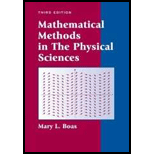
Verify the formulas in Problems 17 to 24.
Want to see the full answer?
Check out a sample textbook solution
Chapter 2 Solutions
Mathematical Methods in the Physical Sciences
Additional Math Textbook Solutions
Mathematics with Applications In the Management, Natural and Social Sciences (11th Edition)
A Survey of Mathematics with Applications (10th Edition) - Standalone book
Using and Understanding Mathematics: A Quantitative Reasoning Approach (6th Edition)
Calculus Volume 1
Introductory Combinatorics
Using & Understanding Mathematics: A Quantitative Reasoning Approach (7th Edition)
 Algebra: Structure And Method, Book 1AlgebraISBN:9780395977224Author:Richard G. Brown, Mary P. Dolciani, Robert H. Sorgenfrey, William L. ColePublisher:McDougal Littell
Algebra: Structure And Method, Book 1AlgebraISBN:9780395977224Author:Richard G. Brown, Mary P. Dolciani, Robert H. Sorgenfrey, William L. ColePublisher:McDougal Littell Trigonometry (MindTap Course List)TrigonometryISBN:9781305652224Author:Charles P. McKeague, Mark D. TurnerPublisher:Cengage Learning
Trigonometry (MindTap Course List)TrigonometryISBN:9781305652224Author:Charles P. McKeague, Mark D. TurnerPublisher:Cengage Learning

